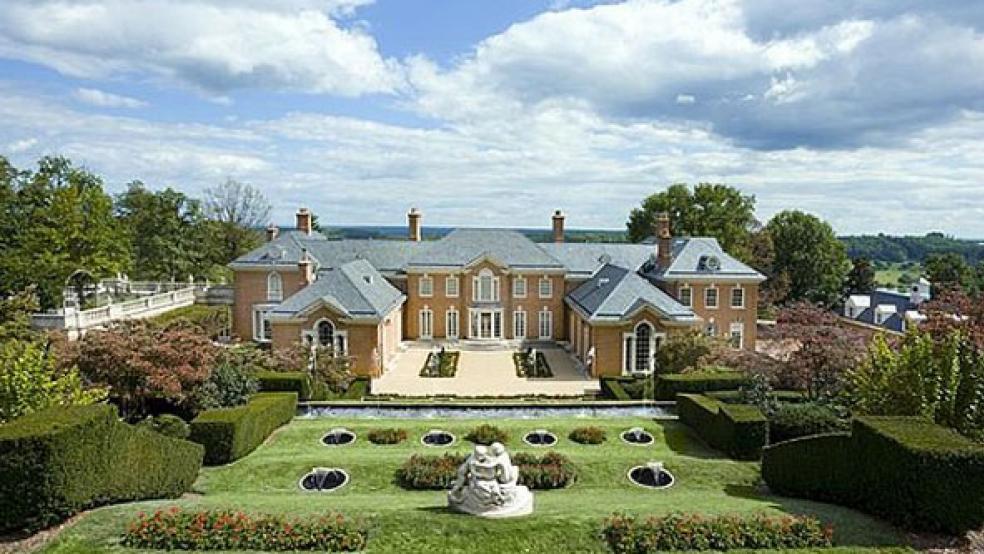When you think of homes in foreclosure, you probably picture broken-down properties with boarded up windows and overgrown yards.
But consider Albemarle, the Charlottesville, Va. manse once owned by Patricia Kluge former billionairespouse of one of the richest men in the country. In addition to a helipad, the house includes a gun room, a wine grotto and a silver vault. Yet her 45-room estate, once worth $100 million, ended up the hands of Bank of America in February, when the bank won the mansion for a mere $15.3 million in a foreclosure auction.
There are very few properties as grand as Albemarle in foreclosure, but a surprising number of luxury homes have been confiscated by banks since the housing crisis — and experts say the number of mansions in trouble is likely to increase. “People always assume that the only [homeowners] to get foreclosed on are poor,” says Rick Sharga, senior vice president at RealtyTrac, a publisher of the nation’s largest database of foreclosure properties. “But that’s just not the case.”
RealtyTrac can’t quantify exactly how many properties in its database belong to the wealthy, but the site reports that one of the fastest growing categories of foreclosures are homes in the $2 million-plus price range. The number of total foreclosures in the U.S. increased by 2 percent between 2009 and 2010. During the same period, however, foreclosures for homes valued at $3 million and more jumped 35 percent in Beverly Hills, 56 percent in Laguna Beach and 65 percent in Pasadena, RealtyTrac reports.
‘Rich people can live paycheck to paycheck,
they just happen to have more zeros
on theirs than the rest of us.’
That trend is likely to accelerate, according to ForeclosureListings.com. Home prices are down 32 percent from their peak in 2006, and expected to continue dropping in 2011. Nationally, one in seven homeowners with a loan of more than $1 million is at least 90-days delinquent on mortgage payments, ForeclosureListings.com reports. That compares with one in 12 homeowners with loans of less than $1 million. Because banks are often slow to seize high-end homes — they’re tough to sell and taxes and maintenance are expensive — there is most likely a big hidden inventory of luxury foreclosures.
But even the super wealthy can run into cash-flow problems. Kluge ran into trouble starting in 1999 when she borrowed heavily to establish her 960-acre Virginia winery as a Mecca for fine vintages. The wines sold well, but Kluge reportedly went on a wild expansion binge. When the housing crisis hit, the value of Albemarle plunged and Kluge couldn’t find a buyer for the vineyard. She had also spent heavily on items like a marble bust of Helios from the 2nd Century A.D. and a Qing Dynasty table clock valued at nearly $4 million.
‘If you’ve paid $15 million for a property, have
$13.5 million worth of debt on it, but now it’s
worth, $7 million, strategically many rich people
decide to just default.’
When your money is tied up in those things, it’s hard to get your hands on it. “In today’s market with credit being so tight, it’s difficult to leverage that capital and get short-term cash that you need to get through tight periods,” says RealtyTrac’s Sharga. “Rich people can live paycheck to paycheck, they just happen to have more zeros on theirs than the rest of us.”
Some of the luxury properties now facing foreclosure were purchased at grossly inflated prices at the peak of the housing market. The credit crisis has made jumbo mortgages for high-end homes harder to secure, further depressing prices for luxury homes in many cities, with prices off by as much as 50 percent. “If you’ve paid $15 million for a property, have $13.5 million worth of debt on it, but now it’s worth $7 million, strategically many rich people decide to just default,” explains Matthew Haines, the founder of Propertyshark.com.
Unlike people who can’t afford to pay for their homes, the mega rich are more likely to make a calculated decision to walk away from a home, says Sharga. “It’s just like you would unload a bad stock purchase, lick your wounds and move on to the next investment.” He says. “They dump it and make it somebody else’s problem.”
And even in wealthy neighborhoods, they do become somebody else’s problem. Foreclosures always have a ripple effect, depressing prices of nearby homes and hurting homeowners who haven’t defaulted. “More houses go on the market and are sold by the banks at distressed rates,” advises Gordon A. Dieterle, a foreclosure mediator and partner at the law firm, McClosky, D'Anna & Dieterle, LLP. “Banks don’t want to be the homeowners or carry the costs, so they’re looking to get rid of inventory. That pushes prices down of houses in the surrounding area.”
In some markets, including Florida and California, many of the high-end foreclosures houses were built on spec when the market was rising and never even occupied. In Sarasota County, Fla., six of the 10 most valuable houses to land in the hands of lenders between 2007 and 2010 went through foreclosure within four years of being built; four of them were reclaimed by lenders within two years of being built, according to the Sarasota Herald-Tribune.
There’s no need to bust out the tissues just yet, of course. Foreclosures hit a record high in 2010, but they were overwhelmingly a middle-class problem. Of the 3.8 million individual foreclosures in 2010, and less than 1.5 percent of them were in the million-dollar plus category, according to the realty research website, Propertyshark.com.





